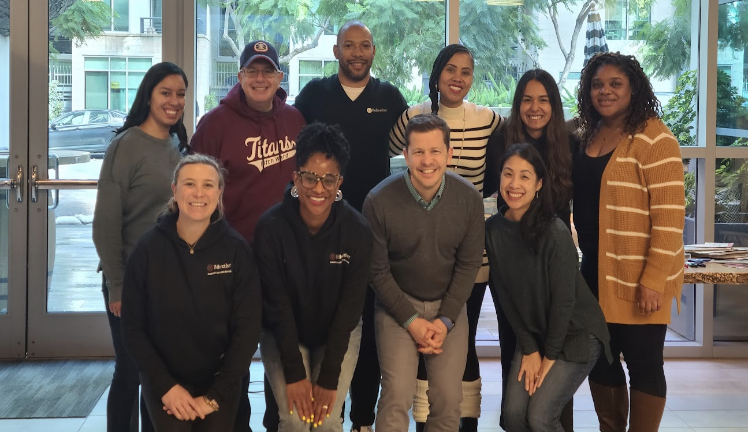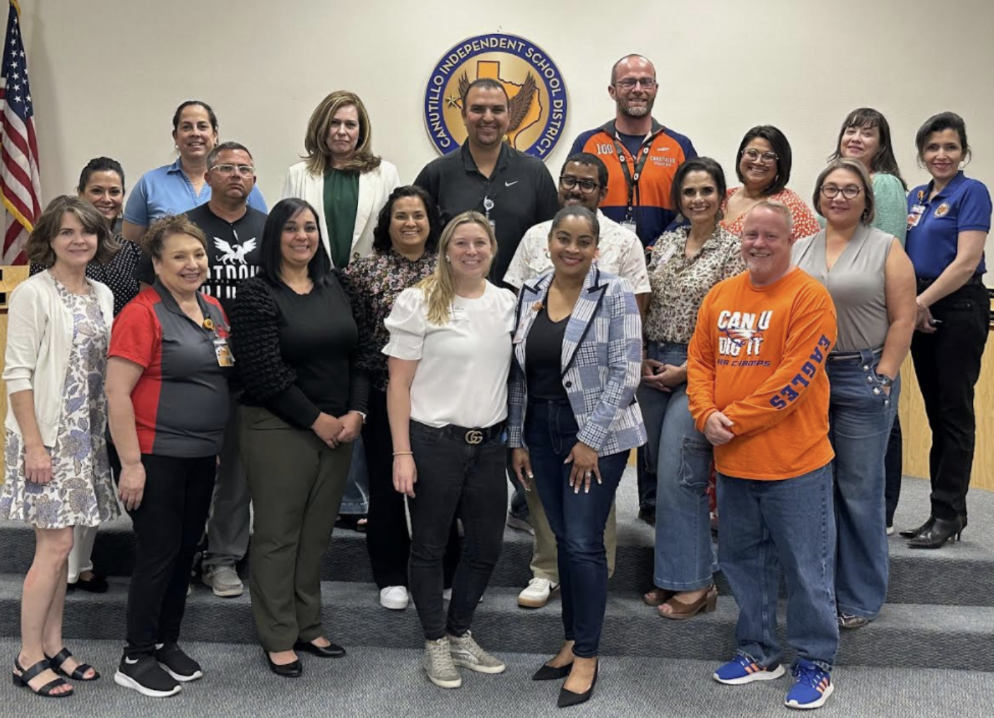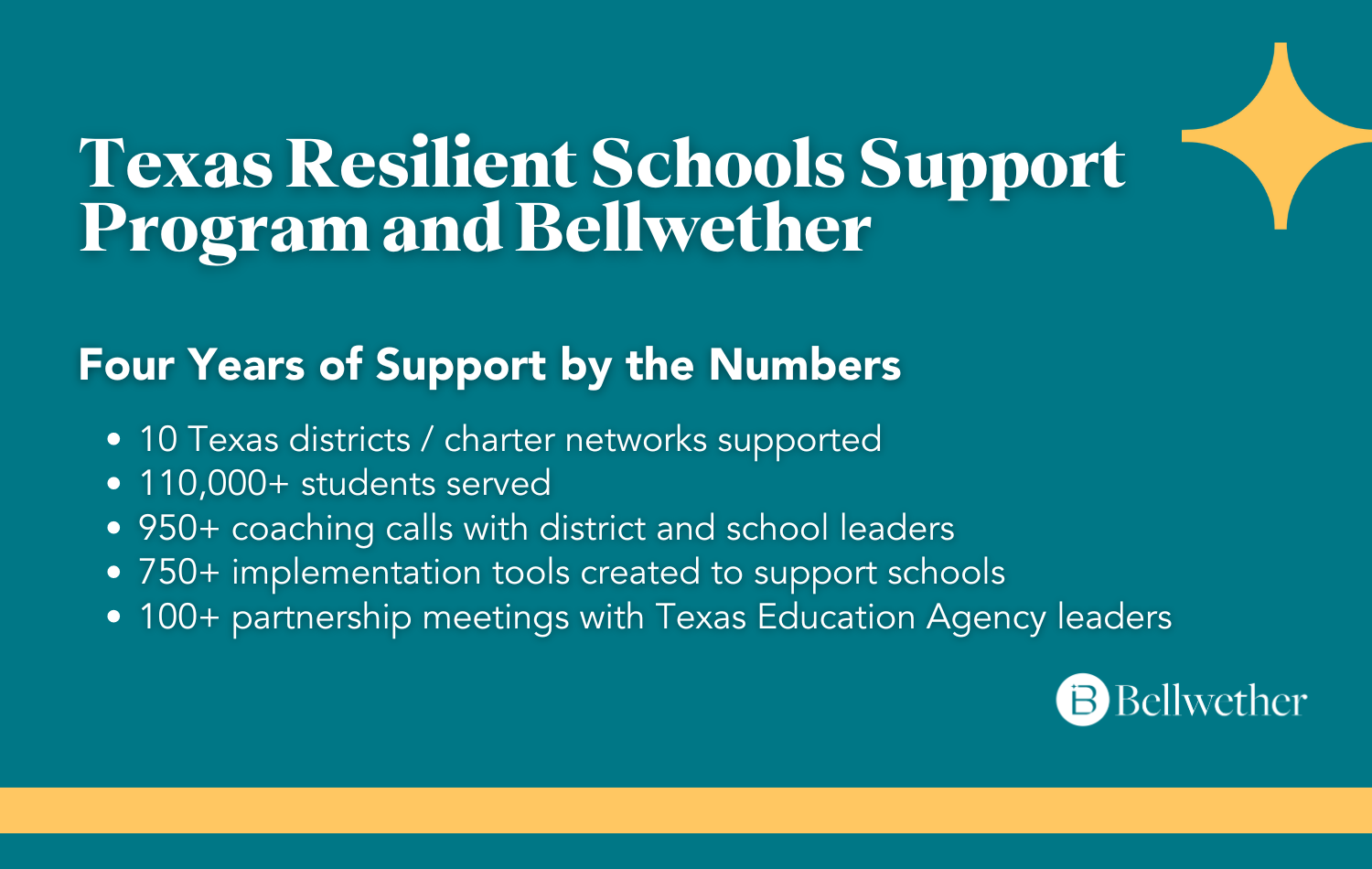When the first schools shuttered in March 2020, the Texas Education Agency (TEA) knew their districts would need support navigating the challenges posed by the COVID-19 outbreak. That support manifested in the Resilient Schools Support Program (RSSP): a robust recovery plan initiative for 180+ districts across the state of Texas affected by pandemic-era school closures. RSSP provided tailored, targeted support to help Texas schools transition to online learning and address student declines in foundational skills and social-emotional learning needs.
Technical Assistance Providers (TAP), including Bellwether, provided pandemic recovery and acceleration plans and continuous implementation assistance to RSSP schools from September 2020 to June 2024. Bellwether’s Academic and Program Strategy (APS) teamlet worked with 10 diverse districts and charter networks across Texas to improve student learning in targeted subgroups and grade levels. Composed of 11 experts, APS has a combined 141 years of experience as teachers, school leaders, and district/charter network leaders, with deep expertise in instructional design, research-based instructional strategies, and implementation.

Each district in the RSSP, paired with a Bellwether APS instructional coach, set a research-based learning acceleration priority; coaches then designed implementation and measurement plans to put those priorities into action to help district leaders and students get back on track post-pandemic.
This is the first in a series on Bellwether’s four-year partnership with the state of Texas through the RSSP. The views below are Bellwether’s only and do not reflect those of the RSSP or an affiliated external agency.
_________________________________________________________________________________________________
A Q&A With a Bellwether Instructional Leadership Coach
In May 2022, Emily Shisler, an associate partner in Bellwether’s APS teamlet, signed on as a coach with the Canutillo Independent School District (ISD) in West Texas. I recently sat down with her to talk about what it was like to partner with Canutillo ISD as part of RSSP: the big wins, the challenges, and the lessons learned along the way.
 Q: Tell us about Canutillo ISD. What were the initial goals of your work with the district?
Q: Tell us about Canutillo ISD. What were the initial goals of your work with the district?
Canutillo is an A-rated, partially rural, partially suburban district nestled between El Paso and the borders of New Mexico and Mexico. Canutillo’s community roots run deep, with many families having lived and worked there for generations. For the first two years of RSSP, Bellwether helped Canutillo bolster its leaders’ coaching of virtual teaching. In the final two years of RSSP, our work shifted, and we reestablished strong Professional Learning Communities (PLCs) — groups of teachers who wish to help students improve their learning. The teachers in the Canutillo PLCs prepared for effective Tier 1 instruction.
Q: What aspects of working with Canutillo ISD were you most excited about?
I was excited to partner with a traditional public district. When I joined Bellwether’s APS teamlet in May 2022, it had been almost two decades since I’d supported a public district. I began my own teaching career in Houston ISD, the seventh-largest public school district in the nation. However, in the years since, I worked in, with, and for charter networks. I was excited to return to a traditional public school, as these districts serve the vast majority of students statewide. Many of them have embraced the movement for high-quality instructional materials, but they sometimes need help with implementation.
It was also my first trip to El Paso. I’ve lived in Texas since 2006, and yet I’d never ventured into the western stretches of the state. Considering my 15+ years in the swamps of Houston, Canutillo’s arid mountains felt like a different planet, let alone state. The vast geographic diversity in Texas creates diversity in the culture, needs, and priorities of any given community. Canutillo is no exception.
Q: What were the goals of your work with Canutillo ISD?
I grabbed the baton to support Canutillo ISD from a Bellwether teammate who’d been their trusted coach for two years. In that time, my teammate worked with deputy superintendents, the executive director of curriculum and instruction, and school principals to tackle two priorities: 1) virtual coaching of virtual teaching in the 2020-21 school year (SY), and 2) the use of high-quality instructional materials in high-dosage tutoring in the following SY21-22. When I came on, I knew that I wanted to maintain strong relationships with all the folks in these roles while I further supported Canutillo’s growth.
During my first year at Canutillo (SY22-23), we aimed to bolster teachers’ content knowledge through PLCs. Considering learning losses from the pandemic, teachers districtwide worked to internalize their curriculum, creating in-house common assessments and analyzing the subsequent student work and data, all with the foremost goal of supporting their students. Canutillo also built strong teacher leaders who facilitated in PLC spaces while bringing in district content leaders to support them. By the end of SY23-24, 100% of Canutillo’s 10 principals agreed that their “PLCs were strong and led to learning” and that teachers thrived in these district-run, content specific PLCs.
Q: What were the most important lessons learned from the RSSP?
We knew students had significant gaps in their learning from 2020 and we knew it was our responsibility to help them learn as much as possible, as quickly as possible. Choosing a research-based strategy to be the core of our work was important. For Canutillo, that meant bringing research-based instructional strategies in math into every classroom. And that also meant shoring up adults’ PLC practices.
Canutillo had PLCs that predated the pandemic. But post-pandemic, the district’s PLCs were uneven in quality. COVID-19 shifted the focus of PLCs to logistics and operations, so they were not as concentrated on building teachers’ knowledge or preparing for excellent Tier 1 instruction as they could have been. We needed to paint the picture of highly effective PLCs and then align every adult to the plan to help make that happen. This meant taking the time to train and explain the operations of the work, and then support the staff after the schools implemented them.
In the end, the work with Canutillo was successful because we focused on the highest-leverage factors with decision-makers, such as building instructional capacity in their leaders. Bellwether was the coach for consistency, and Canutillo ran the plays on the ground. While Canutillo quickly responded to stakeholder feedback, I helped them determine what adjustments to make each step of the way.
Q: What was it like to work in a traditional public district?
I expected healthy skepticism from Canutillo – or perhaps an inclination to keep a third-party provider at an arm’s length. Instead, I was met with warmth and kindness and a seat at the table with district leaders. For example, when I proposed an experiential learning rollout for PLCs, the deputy superintendent responded with enthusiasm and invited me to lead the training. By the following week, school and district leaders gathered to learn with and from me. We shared flautas and plans. It was my first of eight trips to Canutillo over two years. Canutillo was thrilled to have outside partnership and expertise, and they were open to my pushes and ideas along the way.
Smaller, traditional public districts lack the capacity (not capacity as in skill – capacity as in literal people to do the work) that larger districts and charter networks have. With fewer full-time employees, district leadership must be creative and prioritize. Canutillo leadership leans on the experience and decision-making of their school-based leaders and deploys their district-supports strategically.
In addition, what I loved about working with Canutillo was actually working with Canutillo. Sometimes, I built surveys for them. Sometimes, I reviewed the agendas their teams created. Sometimes, I built materials for them to facilitate. My role was equal parts adder-of-capacity, creator-of-materials, partner-for-ideating, and listener. We met weekly in various configurations, bringing together district and school leaders for professional learning as well as data analysis and action planning. Canutillo embraced recommendations while carefully considering the community context and capacity of their schools and leaders.
Q: Did you see major differences between the other schools you had supported and this traditional district?
While a majority of public school districts and charter networks alike are struggling to find and retain talent, Canutillo is part of a thriving and deep-rooted community. More than 75% of its teachers have five-plus years of classroom experience; 50% of its teachers have over 10 years of experience. Students can see themselves in their teachers; many of them share language and aspects of culture and history. And many of the district leaders are graduates of their own schools. In one example, the district math lead I worked alongside for a year was a graduate of the school she teaches in; she, in turn, enrolls her own children in the district.
Canutillo did face significant challenges that were perhaps more acute than a charter might have based on the different types of funding. As we worked through RSSP, budget cuts were significant as ESSR funds waned. It took three tries to pass a bond necessary to keep one of their six elementary schools open. However, through it all, their district leaders maintained a deep commitment to their community and the educators in their schools.
Q: Do you have any final reflections you’d like to share?
We’ve learned so much with and from Canutillo’s deputy superintendent, executive director of curriculum and instruction, curriculum and instruction team, and school-based leaders. Our APS teamlet is proud of our four-year partnership with the district and the impact we partnered to achieve for its students and teachers.
